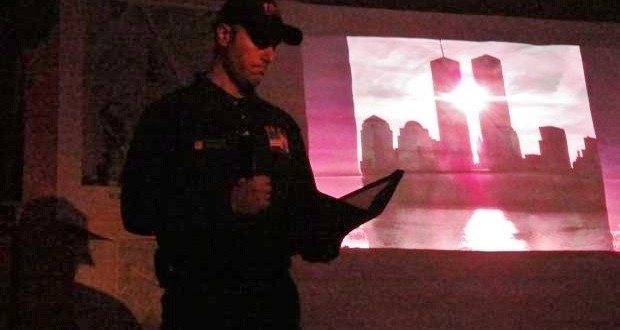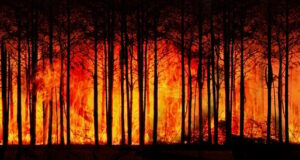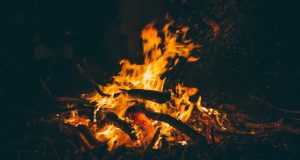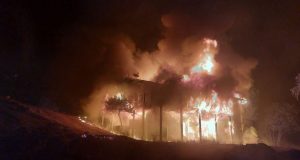Written by Ryan R. Traina, FDNY –
As the sun rose over the steep mountains of the Six Rivers National Forest, my day began with a personal guided tour with Matthew Conklin, the Operations Section Chief of the Southern California Incident Management Team 2. We were operating at the Gasquet Complex fire, located in the northwestern corner of California.
Matthew (Matt) cordially introduced himself and began by giving me quick tour of his U.S. Forest Service Battalion vehicle, which he was utilizing for the incident.
With the blare of the radio in the background, Matt described the operational equipment he had in the Ford Expedition and finished the tour by indicating where I could store my gear. The gear I was required to bring on my trip included a helmet, Nomex wildland brush shirt, Nomex wildland brush pants, 8″ tall boots, my Red Card, an IRPG (Incident Response Pocket Guide), gloves and a wildland fire shelter pack.
We began the tour with a stop at a helicopter dip site located in Division Echo of the Bear fire. The facility offered us a full view of how water tenders supply the water station and how helicopters draw water from the dip tank.
From there, the Operations Section Chief took a narrow winding dirt road leading to the Bear Basin Lookout. The elevation began popping our ears, so I knew the altitude I was experiencing was not one that I was familiar with back in New York.
Matt turned the car around once at the top of the mountainous area and we proceeded to get out and climb the next 50 feet to a lookout.
Once we reached the lookout tower the view was truly spectacular. A site to be seen, as skies stretched as far as the ocean in the west and the smoke laden mountain ridges to the east. Although the views were worth the 45-minute drive, nothing would prepare me for the encounter I would experience shortly after being at Bear Basin Lookout.
We wandered down the mountain in the Battalion vehicle to a location where the Smith River Hotshot crew was working. Once we parked, we began donning our brush fire firefighting apparel and headed down to the point where the firefighters were working.
We then hiked up to a plateau where the firefighters eagerly awaited a briefing from their Captain. The Operations Section Chief respectfully butted in and introduced both of us to the group. The salty group of approximately 20 members sized me up just as any notable firefighter I know would do on the FDNY.
Complete with full gear, burly beards and smoke laden faces, these firefighters were ready to do battle. The Captain continued addressing the unit with his orders on how the unit would proceed with their daily task.
The firefighters stepped aside while eagerly awaiting the sawyers on the crew to begin the delicate task of brushing and limbing before they could begin their work. All the while, the Operations Section Chief and I were in the back of the line conversing while holding our tools with the hopes of following the line up the mountainous terrain.
One member of the team approached us and asked “would you like to join the crew on the line?” I looked at Matt as if to see if it was consistent with his operational plan for the day. He exclaimed “of course!”
That was all the crew needed to hear. He shouted out “Alright Brooklyn, to the front of the line. You’re number 2!” He exchanged my Combi-tool for his Pulaski tool and ordered me up the line.
With no time for a formal explanation of how to work the tool or how to do the job, I instinctively tried to mimic the firefighters progress working in front of me. I was digging and trenching as hard and fast as I possibly could; regardless, it proved to be no match for the talent and work ethic this Hotshot crew possessed. They made it look easy, shouting commands and hollering sounds in-between the loud roar of three chainsaws gunning in the background.
With all the chaos around, this crew knew exactly what they were doing. They dug “line” to the approximate depth as ordered by the quality control officer in the rear of the line. The grueling work that most would shy away from, made the crew seem fulfilled and satisfied with their work.
As my arms began to burn and the sweat dripped profusely, I wondered, “How long can they possibly keep this going?” I kept a quick pace so as not to hold up the process of continuing the line. Quite often you heard “keep the pace going.” I could tell they were satisfied with my work by the occasional comment on how I was “tearing up the line…like an animal!” I hardly felt I was being effective, since it seemed so little was getting accomplished with the amount of effort being put in.
We crossed a small creek and traversed the mountainous region until we met at a gathering point yet again, to discuss the next path we would take. The Captain suggested we continue upwards at an elevation that did not seem normal. Matt asked if I would like to continue with the Hotshots or depart and get back to the rest of the operations tour. I chose to continue with this elite group to get a better taste of the efforts they were working on at this higher elevation. I started off as the last guy in the line, but it only took a minute for the squad boss to yell down the line, member-to-member, to move me back up to the #2 position again.
We began operations at an approximate height of 4,000 ft above sea level. The path they choose to continue on the containment lines proved to take us on an almost sixty degree vertical angle up the mountain side which would be extremely difficult to climb up, let alone to trench the rocky terrain.
As I twisted and contorted my body to push up vertically, I lost balance several times while swing the almost 6 lb. tool. At one point I swung the tool and fell backwards only to strike my right ankle with the adze end of the tool. The excruciating pain made me want me to put the tool down and hobble away, but to see the determination on the other team member’s faces gave me the strength to push on.
We continued up the mountainside, all the while the Hotshots were using a drip torch along the fire line burning off any threatening vegetation. What a familiar feeling, to have fire burning while operating nearby doing the work you were sent to do.
That hour-and-a-half was probably one of the most grueling ninety minutes of my life, but although it was short, I felt we held a similar connection and bond in what we both do. As I was called off the line by Matt, I thanked each member of the crew for the privilege of working with them on that assignment. They all wished me well and said “See-ya Brooklyn, good working with you,” referring to the New York City borough I work in.
The skill level and professionalism of this team showed how serious they take their job. Although this group of smoke eaters were quiet in the beginning, once I was able to demonstrate that I could do the job (even if only for a short while), their respect was earned and they made an urban firefighter feel as if I had worked with them for years.
It’s true; the brotherhood extends from coast to coast, urban to wildland. The aggressive tactics and firefighting styles unite us in a common thread that knows no boundaries, cultural differences or race and /or ethnicity.
I would like to thank the Southern California Incident Management Team 2 and Matthew Conklin the Operations Section Chief for this opportunity. I would also like to extend a thank you to all of the Smith River Hotshots for allowing me the chance to peer into their incredibly arduous lifestyle.
After a 90 minute sampling, I was able to walk away with just a few blisters, some bruises and a number of fond memories of what it’s like to be a Hotshot. However these men and women do this job for 12-16 hours a day for weeks on end. I must admit, I truly respect and honor what they do for our country both as a resident and brother firefighter in battle.
Stay Safe and Stay Low Brothers,
Ryan R. Traina
FDNY Lieutenant Battalion 58, Brooklyn
FDNY Incident Management Team
Public Information Officer
(Reposted from Inciweb – http://inciweb.nwcg.gov/incident/4444/)




